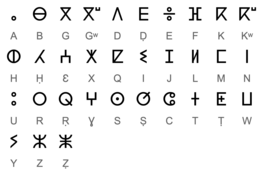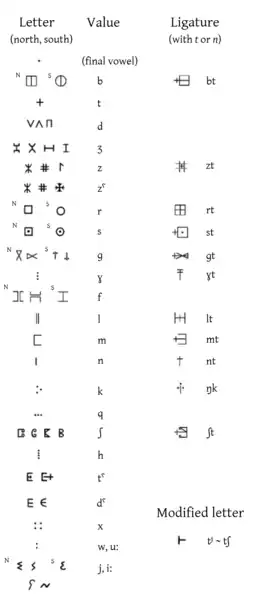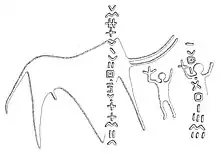Tifinagh
Tifinagh (Tuareg Berber language: ⵜⴼⵏⵗ; Neo-Tifinagh: ⵜⵉⴼⵉⵏⴰⵖ; Berber Latin alphabet: Tifinaɣ; Berber pronunciation: [tifinaɣ]) is a script used to write the Berber languages. Tifinagh is descended from the ancient Libyco-Berber alphabet.[1] The traditional Tifinagh, sometimes called Tuareg Tifinagh, is still favored by the Tuareg Berbers of the Sahara desert in southern Algeria, northeastern Mali, northern Niger and northern Burkina Faso for writing the Tuareg Berber language. Neo-Tifinagh is an alphabet developed by Berber Academy to adopt Tuareg Tifinagh for use with Kabyle; it has been since modified for use across North Africa.[2][3]


Tifinagh is one of three major competing Berber orthographies alongside the Berber Latin alphabet and the Arabic script.[4] Tifinagh is the official script for Tamazight, an official language of Morocco and Algeria. However, outside of symbolic cultural uses, Latin remains the dominant script for writing Berber languages throughout North Africa.[2][5]
The ancient Libyco-Berber script[6][7] (or the Libyc script) was used by the ancient northern Berbers known as Libyco-Berbers,[8][9] also known as Libyc people, Numidians, Afri and Mauretanians, who inhabited the northern parts of Morocco, Algeria, Tunisia and Libya as well as the Canary Islands west of Morocco.
Etymology
The word tifinagh (singular tafinəq < *ta-finəɣ-t) is thought by some scholars to be a Berberized feminine plural cognate or adaptation of the Latin word "Punicus", (meaning "Punic" or "Phoenician") through the Berber feminine prefix ti- and the root √FNƔ < *√PNQ < Latin Punicus; thus tifinagh could possibly mean "the Phoenician (letters)"[10][11][12] or "the Punic letters". Others support an etymology involving the Tuareg verb efnegh, meaning to write.[13] However, the Tuareg verb efnegh is probably derived from the noun "Tifinagh" because all the northern Berbers of Morocco, northern Algeria, Tunisia and northern Libya have a different (and probably older) verb "ari, aru, ara" which means "to write".
Libyco-Berber

Before or during the existence of the ancient Berber kingdoms of Numidia (northern Algeria) and Mauretania (northern Morocco), between 202 BCE–25 BCE, many inscriptions were engraved using the Libyco-Berber script, also known as Ancient Libyan or the Libyc script (libyque). The Libyco-Berber script is found in thousands of stone inscriptions and engravings throughout Morocco, northern Algeria, Tunisia, northern Libya and the Canary Islands.
The exact evolution of both Libyco-Berber and Tifinagh is still unclear.[14] The latter writing system was widely used in antiquity by speakers of the largely undeciphered Numidian language, also called Old Libyan, throughout Africa and on the Canary Islands. The script's origin is uncertain, with some scholars suggesting it is related to, descended or developed from the Phoenician alphabet[15] while others argue an independent conception with slight Phoenician influences.[16] Its first appearance is also uncertain, but it is no older than the first millennium BCE,[17] with the oldest remains likely originating from the 6th century BCE.[18] It disappeared in the northernmost areas of North Africa during the 8th century, after the Arab conquest of the Maghreb, Lybico-Berber along with Latin being replaced by the Arabic script.[19]
The Libyco-Berber script was a pure abjad; it had no vowels. Gemination was not marked. The writing was usually from the bottom to the top, although right-to-left, and even other orders, were also found. The letters took different forms when written vertically than when they were written horizontally.[20]
Tuareg Tifinagh
| Tifinagh | |
|---|---|
 | |
| Script type | |
Time period | Unknown to today |
| Direction | left-to-right, right-to-left script, top-to-bottom, bottom-to-top |
| Languages | Tuareg Berber language |
| Related scripts | |
Parent systems | |
Child systems | Neo-Tifinagh (20th century) |
The ancient Libyco-Berber script branched into the Tuareg Tifinagh script which is used to this day to write the Berber Tuareg languages, which belong to the Berber branch of the Afroasiatic family. Early uses of the script have been found on rock art and in various sepulchres. Among these are the 1,500 year old monumental tomb of the Tuareg matriarch Tin Hinan, where vestiges of a Tifinagh inscription have been found on one of its walls.[22]
According to M. C. A. MacDonald, the Tuareg are "an entirely oral society in which memory and oral communication perform all the functions which reading and writing have in a literate society ... The Tifinagh are used primarily for games and puzzles, short graffiti and brief messages."[14]
Occasionally, the script has been used to write other neighbouring languages such as Tagdal, which belongs to a separate Songhay family.
Orthography
Common forms of the letters are illustrated at left, including various ligatures of t and n. Gemination, though phonemic, is not indicated in Tifinagh. The letter t, +, is often combined with a preceding letter to form a ligature. Most of the letters have more than one common form, including mirror-images of the forms shown here.
When the letters l and n are adjacent to themselves or to each other, the second is offset, either by inclining, lowering, raising, or shortening it. For example, since the letter l is a double line, ||, and n a single line, |, the sequence nn may be written |/ to differentiate it from l. Similarly, ln is ||/, nl |//, ll ||//, nnn |/|, etc.
Traditionally, the Tifinagh script does not indicate vowels except word-finally, where a single dot stands for any vowel. In some areas, Arabic vowel diacritics are combined with Tifinagh letters to transcribe vowels, or y, w may be used for long ī and ū.
Neo-Tifinagh
Development
| Neo-Tifinagh | |
|---|---|
 | |
| Script type | |
Time period | 1970 to present |
| Direction | left-to-right, right-to-left script, top-to-bottom, bottom-to-top |
| Languages | Standard Moroccan Berber and other Northern Berber languages |
| Related scripts | |
Parent systems | ? Egyptian hieroglyphs
|
| ISO 15924 | |
| ISO 15924 | Tfng (120), Tifinagh (Berber) |
| Unicode | |
Unicode alias | Tifinagh |
| U+2D30–U+2D7F | |
Neo-Tifinagh is the modern fully alphabetic script developed by Berber Academy, a cultural association formed by members of the Kabylian diaspora in Paris.[2][24][25][26] The script was developed by modifying Tuareg Tifinagh to accommodate Kabyle phonetics.[2] Neo-Tifinagh was spread by Berber Academy's active promotion of the script, including its usage in their bulletin, Imazighen, which was widely read by Berber communities in Algeria and Morocco.[24][27]
Neo-Tifinagh has since undergone further reform and is used in various contexts throughout North Africa.[2] The Royal Institute of Amazigh Culture has standardized Neo-Tifinagh for use as the official orthography of Standard Moroccan Amazigh, an official language of Morocco.[26][28]
Political history
The creation and promotion of Neo-Tifinagh by Berber Academy was part of its efforts in spreading Berberism throughout the 1960s and 1970s.[24][27] The use of Neo-Tifinagh in their publications was influential in raising Berber consciousness; one reader has described its effect as being "the proof that we actually existed."[24]
The Moroccan state arrested and imprisoned people using Neo-Tifinagh during the 1980s and 1990s.[29] The Algerian Black Spring was also partly caused by this repression of Berber language.[30]
In the 1980s, the Berber flag, which was designed in 1970 and uses the Tifinagh letter z (Tifinagh: ⵣ) from the root of Amazigh, began being used in demonstrations.[31] The flag was adopted by the World Amazigh Congress in 1997.[32]
In Morocco, following the creation of Standard Moroccan Amazigh in 2001, the 2003 adoption of Neo-Tifinagh served as a way to compromise between the deeply split proponents of the Latin script versus the Arabic script as Amazigh's official orthography.[33][5][34] This choice, however, has also resulted in backlash from many Amazigh activists, who find Tifinagh to be limiting when compared to the Latin script.[28][5][34]
In Libya, the government of Muammar Gaddafi consistently banned Tifinagh from being used in public contexts such as store displays and banners.[35] After the Libyan Civil War, the National Transitional Council has shown an openness towards the Berber language. The rebel Libya TV, based in Qatar, has included the Berber language and the Neo-Tifinagh alphabet in some of its programming.[36]
Tifinagh continues to be used as "an emblem of distinctive Berber identity and nationhood."[2]
Modern use
Due to the official adoption of Neo-Tifinagh in Morocco in 2003, the script has been adapted by the Royal Institute of Amazigh Culture for modern digital use.[33][28] Government websites in Morocco may be displayed in Neo-Tifinagh.[37][38]
Starting in 2003, Neo-Tifinagh was used for a small duration of Moroccan elementary school to teach Standard Moroccan Amazigh.[28][3][39] However, practical use of Tifinagh in Morocco remains rare; one Amazigh activist has summarized the situation with the anecdote that he "[knows] that some books that were written in Tifinagh were read by only two people ... the one who wrote the book and the one who did the editing!"[28] Public displays of Tifinagh in Morocco remains restricted primarily to signage and other culturally conspicuous uses.[40]
Despite Neo-Tifinagh's Algerian origins through Berber Academy, the Latin alphabet became the predominant script used amongst Kabylians. Debate in what script to use for Kabylian tends to view the Latin and Arabic scripts as the primary options.[39]
As of 2012, Tifinagh is "not widely used in education or the media in any country."[2]
Letters

The following are the letters and a few ligatures of traditional Tuareg Tifinagh and Neo-Tifinagh:[41]
|
| |||||||||||||||||||||||||||||||||||||||||||||||||||||||||||||||||||||||||||||||||||||||||||||||||||||||||||||||||||||||||||||||||||||||||||||||||||||||||||||||||||||||||||||||||||||||||||||||||||||||||||||||||||||||||||||||||||||||||||||||||||||||||||||||||||||||||||||||||||||||||||||||||||||||||||||||||||||||||||||||||||||||||||||||||||||||||||||||||||||||||||||||||||||||||||||||||||||||||||||||||||||||||||||||||||
|
| ||||||||||||||||||||||||||||||||||||||||||||||||
| Basic Tifinagh (IRCAM)[42] | Extended Tifinagh (IRCAM)[41] | Other Tifinagh letters | Modern Tuareg letters |
Unicode
Tifinagh was added to the Unicode Standard in March 2005, with the release of version 4.1.
The Unicode block range for Tifinagh is U+2D30–U+2D7F:
| Tifinagh[1][2] Official Unicode Consortium code chart (PDF) | ||||||||||||||||
| 0 | 1 | 2 | 3 | 4 | 5 | 6 | 7 | 8 | 9 | A | B | C | D | E | F | |
| U+2D3x | ⴰ | ⴱ | ⴲ | ⴳ | ⴴ | ⴵ | ⴶ | ⴷ | ⴸ | ⴹ | ⴺ | ⴻ | ⴼ | ⴽ | ⴾ | ⴿ |
| U+2D4x | ⵀ | ⵁ | ⵂ | ⵃ | ⵄ | ⵅ | ⵆ | ⵇ | ⵈ | ⵉ | ⵊ | ⵋ | ⵌ | ⵍ | ⵎ | ⵏ |
| U+2D5x | ⵐ | ⵑ | ⵒ | ⵓ | ⵔ | ⵕ | ⵖ | ⵗ | ⵘ | ⵙ | ⵚ | ⵛ | ⵜ | ⵝ | ⵞ | ⵟ |
| U+2D6x | ⵠ | ⵡ | ⵢ | ⵣ | ⵤ | ⵥ | ⵦ | ⵧ | ⵯ | |||||||
| U+2D7x | ⵰ | ⵿ | ||||||||||||||
| Notes | ||||||||||||||||
References
- LBI LIBYCO-BERBER INSCRIPTIONS ONLINE DATABASE
- Campbell, George L. (2012). The Routledge handbook of scripts and alphabets. Christopher Moseley (2nd ed.). Milton Park, Abingdon, Oxon: Routledge. pp. 58–59. ISBN 978-0-203-86548-4. OCLC 810078009.
- Maddy-Weitzman, Bruce (2011). The Berber identity movement and the challenge to North African states (1st ed.). Austin: University of Texas Press. pp. 171–172. ISBN 978-0-292-73478-4. OCLC 741751261.
- Soulaimani, Dris (2016-01-02). "Writing and rewriting Amazigh/Berber identity: Orthographies and language ideologies". Writing Systems Research. 8 (1): 2–5. doi:10.1080/17586801.2015.1023176. ISSN 1758-6801. S2CID 144700140.
- Larbi, Hsen (2003). "Which Script for Tamazight, Whose Choice is it ?". Amazigh Voice (Taghect Tamazight). New Jersey: Amazigh Cultural Association in America (ACAA). 12 (2). Archived from the original on September 7, 2017. Retrieved December 17, 2009.
- Libyco-Berber – 2nd (9th?) century BC-7th century AD
- Written in stone: the Libyco-Berber scripts
- Libyco-Berber relations with ancient Egypt: the Tehenu in Egyptian records
- History of Humanity: From the seventh to the sixteenth century. Edited by Sigfried J. de Laet
- L'ECRITURE LIBYCO-BERBERE: Etat des lieux et perspectives
- Penchoen (1973:3)
- O'Connor (2006:115)
- D. Vance Smith. "Africa's ancient scripts counter European ideas of literacy". Aeon. Retrieved 2021-06-24.
- M.C.A. MacDonald (2005). Elizabeth A. Slater, C.B. Mee and Piotr Bienkowski (ed.). Writing and Ancient Near East Society: Essays in Honor of Alan Millard. T.& T.Clark Ltd. p. 60. ISBN 9780567026910.
- L'ECRITURE LIBYCO-BERBERE: Etat des lieux et perspectives
- Suleiman, Yasir (1996). Language and Identity in the Middle East and North Africa. Psychology Press. p. 173. ISBN 978-0-7007-0410-1.
- Papers of the Peabody Museum of American Archaeology and Ethnology, Harvard University, p. 129
- Written Culture in a Colonial Context: Africa and the Americas 1500 – 1900, p. 11
- Landscapes, Sources and Intellectual Projects of the West African Past: Essays in Honour of Paulo Fernando de Moraes Farias, p. 185
- "Berber". Ancient Scripts. Archived from the original on 2017-08-26. Retrieved 2017-10-09.
- L'ECRITURE LIBYCO-BERBERE: Etat des lieux et perspectives
- Briggs, L. Cabot (February 1957). "A Review of the Physical Anthropology of the Sahara and Its Prehistoric Implications". Man. 56: 20–23. doi:10.2307/2793877. JSTOR 2793877.
- L'ECRITURE LIBYCO-BERBERE: Etat des lieux et perspectives
- Aïtel, Fazia (2014). We are Imazigen : the development of Algerian Berber identity in twentieth-century literature and culture. Gainesville, FL. pp. 115–116. ISBN 978-0-8130-4895-6. OCLC 895334326.
{{cite book}}: CS1 maint: location missing publisher (link) - Ilahiane, Hsain (2017). Historical dictionary of the Berbers (Imazighen) (2nd ed.). Lanham, Maryland. pp. xlix. ISBN 978-1-4422-8182-0. OCLC 966314885.
{{cite book}}: CS1 maint: location missing publisher (link) - African Literacies: Ideologies. Abdelhay, Asfaha, Yonas Mesfun. Newcastle upon Tyne. 2014. pp. 151–152. ISBN 978-1-4438-6826-6. OCLC 892969053.
{{cite book}}: CS1 maint: location missing publisher (link) CS1 maint: others (link) - Maddy-Weitzman, Bruce (2011). The Berber identity movement and the challenge to North African states (1st ed.). Austin: University of Texas Press. p. 75. ISBN 978-0-292-73478-4. OCLC 741751261.
- Soulaimani, Dris (2016-01-02). "Writing and rewriting Amazigh/Berber identity: Orthographies and language ideologies". Writing Systems Research. 8 (1): 12–14. doi:10.1080/17586801.2015.1023176. ISSN 1758-6801. S2CID 144700140.
- "Rapport sur le calvaire de l'écriture en Tifinagh au Maroc". Amazighworld.org. Archived from the original on 2009-05-03. Retrieved 2017-10-09.
- "Algérie: 10 ans après son « printemps noir », la Kabylie réclame justice – Jeune Afrique". JeuneAfrique.com (in French). 2011-04-20. Retrieved 2021-05-08.
- Fedele, Valentina (2021), The Hirak. The Visual Performance of Diversity in Algerian Protests, University of Salento, p. 693, doi:10.1285/i20356609v14i2p681, retrieved 2022-12-20
- Ilahiane, Hsain (2017). Historical dictionary of the Berbers (Imazighen) (2nd ed.). Lanham, Maryland. p. 29. ISBN 978-1-4422-8182-0. OCLC 966314885.
{{cite book}}: CS1 maint: location missing publisher (link) - Larrier, Renée Brenda; Alidou, Ousseina, eds. (2015). Writing through the visual and virtual: inscribing language, literature, and culture in Francophone Africa and the Caribbean. Lanham, Maryland. pp. xii. ISBN 978-1-4985-0164-4. OCLC 1249711011.
{{cite book}}: CS1 maint: location missing publisher (link) - Silverstein, Paul; Crawford, David (2004). "Amazigh Activism and the Moroccan State". Middle East Report (233): 46. doi:10.2307/1559451. ISSN 0899-2851. JSTOR 1559451.
- سلطات الامن الليبية تمنع نشر الملصق الرسمي لمهرجان الزي التقليدي بكباو [Libyan security authorities to prevent the publication of the official poster for the festival traditional costume Pkpau] (in Arabic). TAWALT. 2007.
- "Libya TV – News in Berber". Blip.tv. Retrieved 2015-07-14.
- "ⴰⴷⵓⵙⵜⵓⵔ". Maroc.ma. 2021-11-17. Retrieved 2022-12-20.
- "Institut Royal de la Culture Amazighe". Ircam.ma. Archived from the original on April 21, 2008. Retrieved 2015-07-14.
- Maddy-Weitzman, Bruce (2011). The Berber identity movement and the challenge to North African states (1st ed.). Austin: University of Texas Press. pp. 193–195. ISBN 978-0-292-73478-4. OCLC 741751261.
- "Morocco draft law on official use of Berber language scrutinised". BBC Monitoring Middle East. August 4, 2016.
- P. Andries, Proposition d'ajout de l'écriture tifinaghe. Organisation internationale de normalisation Archived 2020-10-21 at the Wayback Machine, Jeu universel des caractères codés sur octets (JUC). ISO/IEC JTC 1/SC 2 WG, vol.2, p.2739R, 2004.
- "Polices et Claviers Unicode" (in French). IRCAM. Archived from the original on 2012-03-10. Retrieved 2012-08-20.
Bibliography
- Aghali-Zakara, Mohamed (1994). Graphèmes berbères et dilemme de diffusion: Interaction des alphabets latin, ajami et tifinagh. Etudes et Documents Berbères 11, 107–121.
- Aghali-Zakara, Mohamed; and Drouin, Jeanine (1977). Recherches sur les Tifinaghs- Eléments graphiques et sociolinguistiques. Comptes-rendus du Groupe Linguistique des Etudes Chamito-Sémitiques (GLECS).
- Ameur, Meftaha (1994). Diversité des transcriptions : pour une notation usuelle et normalisée de la langue berbère. Etudes et Documents Berbères 11, 25–28.
- Boukous, Ahmed (1997). Situation sociolinguistique de l’Amazigh. International Journal of the Sociology of Language 123, 41–60.
- Chaker, Salem (1994). Pour une notation usuelle à base Tifinagh. Etudes et Documents Berbères 11, 31–42.
- Chaker, Salem (1996). Propositions pour la notation usuelle à base latine du berbère. Etudes et Documents Berbères 14, 239–253.
- Chaker, Salem (1997). La Kabylie: un processus de développement linguistique autonome. International Journal of the Sociology of Language 123, 81–99.
- Durand, O. (1994). Promotion du berbère : problèmes de standardisation et d’orthographe. Expériences européennes. Etudes et Documents Berbères 11, 7–11.
- O’Connor, Michael (1996). "The Berber scripts". In William Bright; Peter Daniels (eds.). The World's Writing Systems. New York: Oxford University Press. pp. 112–116.
- Penchoen, Thomas G. (1973). Tamazight of the Ayt Ndhir. Los Angeles: Undena Publications.
- Savage, Andrew. 2008. Writing Tuareg – the three script options. International Journal of the Sociology of Language 192: 5–14
- Souag, Lameen (2004). "Writing Berber Languages: a quick summaryurl=https://web.archive.org/web/20041205195808/http://www.geocities.com/lameens/tifinagh/index.html". L. Souag. Archived from the original on 2004-12-05. Retrieved 28 June 2014.
- Encyclopaedia of Islam, s.v. Tifinagh.
External links
- lbi-project.org, a database of Libyco-Berber inscriptions with images and information
- Academic papers on the Libyco-Berber inscriptions
- ancientscripts.com – Berber, a fact file on Tifinagh and a legend of characters
- artistic Tifinagh fonts